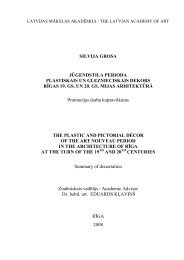Institute of Art History of the Latvian Academy of Art Anna Ancāne ...
Institute of Art History of the Latvian Academy of Art Anna Ancāne ...
Institute of Art History of the Latvian Academy of Art Anna Ancāne ...
You also want an ePaper? Increase the reach of your titles
YUMPU automatically turns print PDFs into web optimized ePapers that Google loves.
plasticity. No direct borrowings <strong>of</strong> gable décor are found in Riga; <strong>the</strong><br />
silhouettes are quite complex but unified, with clear composition,<br />
classical order elements and expressive ornamentation.<br />
Volutes with acanthus ornament were <strong>the</strong> main decorative element <strong>of</strong><br />
Riga’s gables in <strong>the</strong> last decade <strong>of</strong> <strong>the</strong> 17 th century and <strong>the</strong> very beginning<br />
<strong>of</strong> <strong>the</strong> 18 th century. Their origins are found in <strong>the</strong> samples <strong>of</strong> Amsterdam<br />
architecture as well as in Dutch gables adapted in Hamburg. Acanthus<br />
volute gables in Riga have been linked to <strong>the</strong> names <strong>of</strong> Henicke and<br />
Bindenschu. These gables were sometimes enriched by architectural<br />
décor, like pilasters, thus taking on <strong>the</strong> look <strong>of</strong> <strong>the</strong> <strong>the</strong>n popular<br />
“Vingboons’ gables”. There were cases when <strong>the</strong> volute did not merge<br />
with <strong>the</strong> gable smoothly but created a sharp, seemingly cut-out silhouette,<br />
like <strong>the</strong> one with six massive volutes on <strong>the</strong> end façade <strong>of</strong> <strong>the</strong> building at<br />
4 Mazā Jauniela, facing <strong>the</strong> Town Hall Square (comparable with<br />
examples at 21 Pelzerstraße and Cremon No. 24 in Hamburg).<br />
A Baroque gable with acanthus volutes at 10 Mazā Minsterejas Street had<br />
survived up to <strong>the</strong> 1920s. The flowing, dynamic acanthus lines as well as<br />
<strong>the</strong> silhouette <strong>of</strong> <strong>the</strong> gable allow dating it by <strong>the</strong> early 1690s. Similar<br />
examples decorated <strong>the</strong> buildings constructed between <strong>the</strong> ramparts after<br />
<strong>the</strong> fire <strong>of</strong> 1689 and are dated approximately by 1690 – 1692. The most<br />
splendid were located at 1 and 7/9 Zirgu Street.<br />
Vingboons’ type gables with pilasters<br />
There were gables complemented with <strong>the</strong> architectural décor <strong>of</strong> pilasters.<br />
The oldest known example has been located on <strong>the</strong> building at 21<br />
Grēcinieku Street (1682), prototypes for which are found in <strong>the</strong> buildings<br />
designed by Vingboons in Amsterdam. This kind <strong>of</strong> décor had been used<br />
also at <strong>the</strong> corner <strong>of</strong> Smilšu and Aldara Streets, 16 and 22 Smilšu Street<br />
as well as at 28 Jauniela, 20 Mārstaļu Street, 9 Lielā Monētu Street, 17<br />
Tirgoņu Street, 20 Mārstaļu Street. These lost examples and <strong>the</strong> gable at 8<br />
Miesnieku Street allows establishing a typological group in Riga,<br />
described as “Vingboons’ type” in <strong>the</strong> specialised literature.<br />
V. 3. Portals<br />
Already in <strong>the</strong> 1950s Aleksandrs Birzenieks singled out two main<br />
compositional schemes <strong>of</strong> Riga’s portals – decorative and tectonic. The<br />
first comprised portals in which decorativeness predominated over <strong>the</strong><br />
constructive side; <strong>the</strong> tectonic group included various relationships <strong>of</strong><br />
classical order elements. Several examples give an insight into <strong>the</strong> mid-<br />
17 th century portals.<br />
V.3.1. 1 st half <strong>of</strong> <strong>the</strong> 17 th century – 1650<br />
Mid-century portals demonstrate a dual tendency – a system <strong>of</strong><br />
architectural décor taken over from <strong>the</strong> late Renaissance as well as<br />
ornamental compositions permeated with Mannerist forms. The portal<br />
located on <strong>the</strong> former mint house at 16 Mazā Monētu Street (1644),<br />
22












